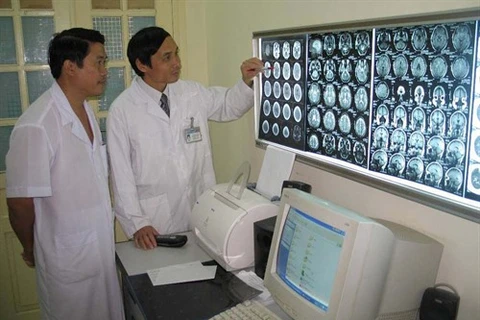Hanoi (VNA) - Lung transplants will become a common practice in Vietnam, starting from 2017, said top local organ transplant surgeons.
Deputy Head of the Tuberculosis and Pulmonology Department under Military Hospital 103, Ta Ba Thang, has recently voiced his forecast on the outlook of lung transplants in Vietnam in the near future.
According to Thang, ever-developing technology and modern science as well as the mastery of Vietnamese doctors in other organ transplant techniques including heart, liver and kidney, together with increasing organ donations will form the foundation for the first regular lung transplant to be performed next year.
Worldwide, the number of lung transplants has been on the rise through the years.
Those with chronic obstructive pulmonary disease (COPD), idiopathic pulmonary fibrosis, bronchiectasis and early stage lung cancer are all amenable to lung transplants.
Patients receiving lung transplants had demonstrated improved quality of life and higher longevity, Thang said.
Currently, there are two types of lung transplant based on donor source: lungs from brain-dead patients and those from living donors.
In the case of living donors, there are two main techniques: taking two lower lobes from two separate donors to transplant into the recipient, or using the lower lobe from a donor.
As per Dr Thang’s analysis, living lung transplants offer many advantages over the cadaver alternative, hence its rising popularity.
First, the sources for living lobar transplants are more available. The patient’s biological parents, siblings, cousins, and blood relatives are encouraged to donate their lung’s lobes.
Second, lobectomy, or the removal of the lower lobe, won’t affect the donor’s long-term health or quality of life despite a reduction in lung volume. The donor’s optimal age is between 20 and 60 years old.
Third, with living donors, the surgery is elective, and medical examinations or surgery can be more proactively arranged when the conditions are favourable.
Fourth, in Vietnam, where it is much harder to persuade people to donate organs from relatives who are clinically dead, living donation is the more viable alternative.
Fifth and last, the ischemic time (cold time) during surgery is shorter, causing less damage to the tissue. Complications in living transplant cases are also less likely than the cadaver options, with a lower risk of infection or primary graft dysfunction (PGD).
However, live lobe transplant surgery is relatively more complicated; the risk of complications to the donors is minimal, but cannot be dismissed. There’s also the need for pre-op and post-op psychological counselling for both donors and recipients.
“Similar to other types of organ transplant, lung transplant patients may suffer from organ rejection, PGD, among other conditions, leading to dyspnea, respiratory failure, and potentially, death. Survival rates still vary depending on the type of the disease, its severity or stage, and transplant indication”, Thang said.
“Thus, the screening and evaluation of donors and patients are of the utmost importance.”
According to Nguyen Tien Quyet, former Director of the Vietnam-Germany Hospital and a leading expert on organ transplant, by the end of 2015, Vietnamese doctors have performed 1,500 kidney transplants, 50 liver transplants, 13 heart transplants and 1 lung transplant.
In 2015, there was a case of a heart-lung transplant performed in Hue Central Hospital, however, the donated lungs had already severely deteriorated, and the 40-year-old male patient unfortunately passed away five days after surgery, even with best efforts from local and foreign experts.
Lung transplants will open up new opportunities for treating patients with early stage lung cancer or COPD – an increasingly common condition in Vietnam, because of heavy smoking or environmental pollution, Quyet said.
On the bright side, with remarkable progress in recent years, the success rate of transplants is increasing, bringing a better life for patients.-VNA

Mekong Delta lacks specialised medical staff
The Mekong Delta region is facing a serious shortage of medical staff in five rare specialities including tuberculosis, leprosy, psychiatry, surgery and forensic science, a seminar heard on August 15.























